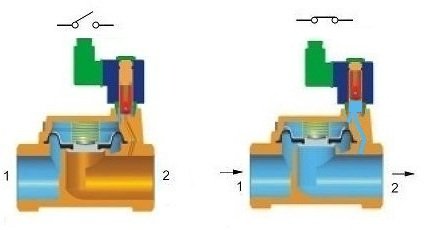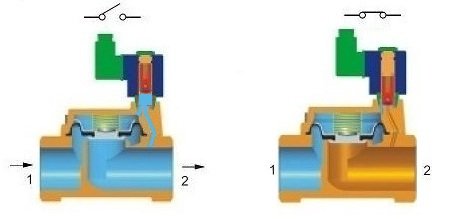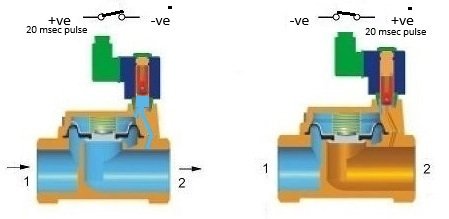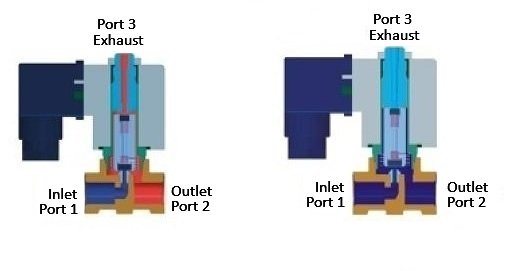Understanding Solenoid Valve Functions: A Comprehensive Guide
Solenoid valves are pivotal components in fluid control systems, offering precise regulation of liquids and gases across various industries. Their functionality is defined by their configuration, operation mode, and application requirements. This guide delves into the diverse functions of solenoid valves, aiding in selecting the optimal valve for your specific needs.
2/2-Way Solenoid Valves: Direct Flow Control
2/2-way solenoid valves feature two ports—an inlet and an outlet—and operate in two positions: open or closed. They are categorised based on their default state when de-energised:

Normally Closed (Failsafe Closed)
In this configuration, the valve remains closed without power, preventing flow. Applying electrical power opens the valve, allowing media passage. This setup is ideal for applications requiring a fail-safe mechanism to stop flow during power outages.

Normally Open (Failsafe Open)
Conversely, normally open valves stay open when de-energised and close upon power application. They are suitable for systems where continuous flow is essential, and stopping flow during power loss is undesirable.

Latching (Bi-Stable) Solenoid Valves: Energy-Efficient Operation
Latching solenoid valves, also known as bi-stable valves, require only a brief electrical pulse to change states—open or closed—and maintain that state without continuous power. This energy-efficient design is perfect for battery-powered or remote systems where power conservation is critical.

3/2-Way Solenoid Valves: Versatile Flow Direction
3/2-way valves have three ports and two positions, enabling more complex flow control:
Normally Closed: The valve blocks flow from the inlet 1 to the outlet 2when de-energised. Energising the valve opens this path while closing the exhaust port 3.
Normally Open: The valve allows flow from the inlet 1 to the outlet 2 when de-energised. Applying power redirects flow from port 1 to the exhaust port 3.
Universal Function: These valves can be configured for either normally open or closed operations, offering flexibility in system design with flow in both directions.
5/2 and 5/3-Way Solenoid Valves: Advanced Pneumatic Control
For pneumatic applications requiring precise actuator control, 5/2 and 5/3-way valves are employed:
5/2-Way Single Acting: Utilises one coil and a spring return mechanism. Energising the coil shifts the valve, and de-energising returns it to the original position.
5/2-Way Double Acting: Features two coils for bidirectional control. Energising each coil shifts the valve in opposite directions, maintaining position until the alternate coil is energised.
5/3-Way Double Acting: Incorporates two coils and a central neutral position. This allows for stopping the actuator mid-stroke, providing enhanced control in complex systems.
Direct Acting vs. Servo Assisted Operation
Solenoid valves operate via two primary mechanisms:
Direct Acting: The solenoid directly actuates the valve mechanism, suitable for low-flow or zero-pressure differential applications.
Servo Assisted (Pilot Operated): Utilises system pressure to assist in valve operation, ideal for high-flow applications but requires a minimum pressure differential to function correctly.
Selecting the Right Solenoid Valve Function
Choosing the appropriate solenoid valve involves considering factors such as:
Application Requirements: Determine the necessary flow control—on/off, diverting, or mixing.
System Pressure and Flow Rates: Ensure compatibility with system specifications.
Power Availability: Assess if continuous power is available or if energy-saving options like latching valves are preferable.
Fail-Safe Needs: Decide if the system should default to open or closed during power failures.
For assistance in selecting the optimal solenoid valve, utilise our Solenoid Valve Search Wizard or contact our expert team for personalised support.
Valve Online Store + Information.

Try our Solenoid Valve Search Wizard by function (2/2 3/2 5/2 5/2 way - direct acting pressure assisted or latching), body material (brass, stainless, plastic).
The simple way to find what you are looking for, or just enter the part number in the "search for products" tab from the brand you have at, let the store do the rest.
